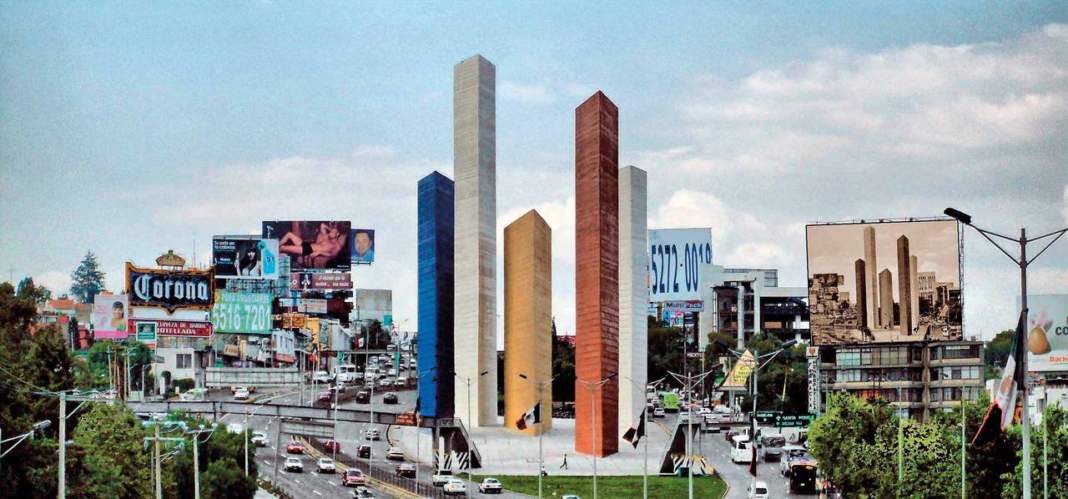Luis Barragán, Satélite Towers, Mexico City, 1957
The capital of the Estados Unidos Mexicanos (the country’s official name according to article 44 of its constitution) in addition to being the seat of power of the union is, itself, a Federal District; thus it is a political, economic and social agglomeration to which the term of “city”, also in the light of the over 25 million people who inhabit the entire metropolitan area, appears rather inadequate. In the annual urban reports published by the United Nations, Mexico City was, in 2003, the second largest megalopolis in the world, after Tokyo, for number of inhabitants, with a growth rate that, though somewhat slower than during the Eighties and Nineties, shows no signs of ceasing; it is the eighth metropolis on the planet for Gross Domestic Product, one of the most sprawling, with a latitude of over fifty kilometers in the north-south direction and about 35 kilometers along the east-west line, at an altitude of 2300 meters above sea level. This enormous mass of buildings and concentration of people, which has grown with extreme rapidity, as the architect and critic Jose Castillo reports “only in the last 100 years, is the cause of one of the greatest environmental upheavals in process in the history of human activities, the beginning of the end of an ecosystem where every form of previous natural life has disappeared. The ancient group of lakes that occupied much of the area of the Federal District to form a rich basin of water has been drained over the years; already in 1900 president Diaz inaugurated a complex of works to drain all the aquifers in the valley and suppress of every form of lacustrian life. In time, all the forests that stretched up into the surrounding mountains disappeared, and with them most of the fauna. The predictable ecological and environmental disaster reached its peak at the beginning of the Eighties when, in the face of the obvious, unsustainable condition of atmospheric pollution, through a policy of fiscal incentives and facilitations, the city finally undertook a project for the decentralization of part of the industrial activities, distributed in over 54 industrial parks that extend on an area of 2,500 hectares; it also intensified the improvement and construction of a vast public transport system centered on the subway network undertaken starting in 1969 – with over 180 stations spread in 12 lines that permit the daily movement of about 5 million passengers – with provision for the creation of a system of air quality control and monitoring –, and introduced the method of alternate license plate numbers for motor vehicle circulation; it has even declared over half the territory an Ecological Reserve Area. However, it is easy to understand how every possible attempt to respond to the problems of a similar human concentration is thwarted by the complexity of living conditions which are always subject to the occurrence of uncontrollable events, from the floods of the old days to the recent earthquakes – the one in 1985 was particularly violent and destructive – or foreseeable and known events that, at the same time, tend to occur imperceptibly, like the creation of the so-called “informal city”, where it is next to impossible to combat poverty, crime, traffic, crowding, pollution, the quality of the buildings and urban spaces. Juan Villoro, a Mexican writer and journalist, described the city as “…an untidy galaxy…” in which, he declares, simply: “… there are too many of us”. And also with respect to the demographic increase and urban growth: “We have a bizarre situation here: we moved to a different city without ever leaving home, we live in a nomadic metropolis”. Effectively, the city and the conditions of its inhabitants change continually, while the decision timing of politics and urban science, even when endowed with exceptional analytical and synthetic skill, and able to formulate valid project proposals, is always late with respect to the living needs in a place that seems like a sort of gigantic particle accelerator powered by the pressure of the economy and speculation that compresses every bit of breathing space and never stops. According to Javier Barreiro Cavestany, “Before such an apocalyptic scenario, it is almost a miracle that the city functions at all. But it is not less surprising that, in the midst of the chaos of traffic, the problems of waste disposal, pollution, speculation, the mafias and social conflicts, the city continues to produce top quality designer architecture”. Just as it must not surprise us that in some cases, certain portions of the fabric that have grown spontaneously discover a vital dimensions of their own, that is multifunctional, multiethnic and thus multicultural: a dimension that basically expresses the very identity of Mexico City, what it means to be a megalopolis.





